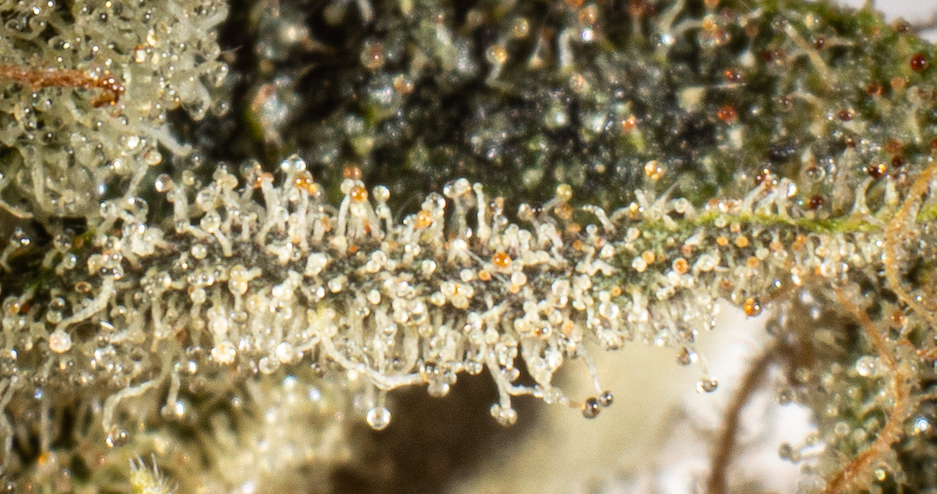If you’ve ever opened a jar of cannabis and been pleasantly surprised by its zesty, lemony scent, you’ve already had first-hand experience with terpenes. In fact, many of the fruits and vegetables we eat contain terpenes, so you interact with terpenes every time you enjoy a healthy meal or snack.
Terpenes, or terps for short, are aromatic oils produced in plants that create distinctive scents and flavors. In marijuana plants, specifically, they’re secreted from the same glands that produce THC, CBD, and other lesser-known cannabinoids, like CBDA or CBC. In this blog, we’ll look at the most common cannabis terpenes and their benefits before answering a few questions our patient service coordinators get the most often about terpenes.
Limonene
Limonene (Lm) is a highly aromatic terpene and occurs naturally in orange and lemon rinds. As such, it produces a strong citrus scent profile in marijuana and strains with the terms “lemon” or “sour” in their name often contain limonene. Limonene offers an array of health benefits, including acting as an anti-inflammatory and antioxidant. According to one study, D-limonene actually inhibited the growth of lung cancer cells and suppressed the growth of transplanted tumors in mice!
Ocimene
Ocimene (On) produces a sweet, earthy aroma often used in perfume. It’s also found in mint, hops, bergamot, and pepper, so if your cannabis has any of these scent profiles, there’s a strong chance it contains ocimene. One interesting thing about ocimene is that common pests (like aphids) stay away from strains that contain ocimene the same way mosquitoes stay away from citrus oils. For this reason, it’s believed to be a natural part of a plant’s defense mechanism.
beta-Myrcene
Myrcene (Mc) is an incredibly common terpene and makes up over 20% of the terpene profiles within the marijuana market. It’s so common that virtually every strain has some level of this terpene; in some strains alone, beta-Myrcene can make up 65% of its terpene profile! Its effects have been described as “calming,” and it’s often found in indicas with sedative effects. In addition, it’s incredibly helpful in reducing inflammation and is often used as a supplement by cancer patients to help relieve chronic pain.
Caryophyllene
Found in CULTA’s Dosidos #22/22, Fritter Licker, Guava Lava, Hot Mint Sundae, Poochie Love, Sugar Biscuits #9, and Tic Tacs strains, caryophyllene (Cr) is a spicy terpene found in cinnamon, cloves, oregano, and black pepper. It’s abundant in strains that are high in THC and is a common ingredient in anti-inflammatory topicals and creams used for arthritic pain. Caryophyllene is unique from other terpenes in that it binds with endocannabinoid receptors (other terpenes bind with receptors in the central nervous system) -- this property is what gives it its strong pain relief capabilities.
Linalool
Another incredibly common terpene, Linalool (LN), has powerful relaxing properties. It has spicy and floral notes and is also found in cinnamon, lavender, mint, and coriander. Research suggests that linalool can impact one’s mood and sleep, and animal and human studies have shown that its sedative effects can help calm an overactive nervous system. For this reason, strains containing linalool may be a good choice for patients that suffer from anxiety, depression, epilepsy, and chronic stress. It’s also a natural bug repellent.
alpha-Pinene
In this case, it’s all in the name. As you may have guessed, pinene (Pn) is found primarily in pine needles. It’s the most commonly occurring terpene in nature and is divided into two varieties: alpha-pinene (more common in cannabis) and beta-pinene (more likely to be found in other plant life, like pine trees, rosemary, and basil.) Pinene is unique in that it has possible effects on the respiratory system, and it’s currently being researched as a bronchodilator or a substance that helps open airways.
Terpinolene
Terpinolene (Te) is a citrus-forward terpene that’s also found in nutmeg, cumin, and lilac. Unlike other terpenes that have a very distinct, strong scent, terpinolene has a citrus scent profile in some strains and a floral profile in others. Though it’s the least common terpene found in marijuana flower, CULTA patients can find terpinolene in Amnesia OG and Durban Poison. Research shows that terpinolene has antifungal and antibacterial properties, and it’s a common ingredient in hand soaps.
Humulene
Humulene (Hu) is the terpene found in beer hops, and is often described as being earthy or musky. Also found in balsam, black pepper, and ginger root, it carries many potential medical and therapeutic properties. Early research shows that this terpene, specifically, has anti-cancer potential, and other studies show that it can suppress appetite. One interesting thing about humulene is that it has complementary effects when paired with other terpenes, and traces of it are typically found wherever caryophyllene is.
Terpene FAQs
If you’re just learning about terpenes, you probably have some questions! So we asked our very own patient coordinators to answer some of the terpene questions they are asked the most often.
How are terpenes different from cannabinoids?
Terpenes and cannabinoids are both organic compounds that exist in the cannabis plant. They’re entirely different molecules - cannabinoids modulate the endocannabinoid system, which is the part of the body responsible for regulating sleep, mood, and appetite. Terpenes, on the other hand, are responsible for the flavor and scent profiles of marijuana.
Do terpenes have a psychoactive effect?
Terpenes don’t have a psychoactive effect on their own, but they can when combined with other cannabinoids.
What is the difference between botanically-derived and cannabis-derived terpenes?
The primary difference between botanically-derived and cannabis-derived terpenes is that botanically-derived terpenes come from other plants (or they’re synthesized in a lab), and cannabis terpenes are exclusive to the cannabis plant. You can learn more in our in-depth article.
What do terpenes do?
Though studies suggest that terpenes can have therapeutic effects, they’re primarily responsible for the way cannabis smells and tastes. Different terpenes have different scents and flavors.
Are terpenes found in other fruits or vegetables?
Terpenes are found in virtually every fruit, vegetable, herb, and spice. Even beer contains terpenes since hops contain terpenes and is a common ingredient in beer.
How can I identify terpenes on a cannabis label?
Though terpenes aren’t a standard inclusion on cannabis labels, many marijuana brands include this information directly on their labels. If this information isn’t included on a cannabis label, simply ask your budtender to break down the terpene profile for you. This is something they should be able to find out for you.
Are terpenes good or bad for you?
Terpenes are really only “bad” in a concentrated form, as they can cause allergic reactions in high concentrations. The terpenes you’ll absorb from fruits, vegetables, and cannabis, though, are safe.
Do terpenes relax you?
Some terpenes (linalool especially) have relaxing properties.
The Science Behind Cannabis
At CULTA, we love the science behind marijuana -- that’s just one of the reasons our cannabis is continually regarded as a favorite in Maryland. To learn more about the “science” behind marijuana, check out Tissue Culture in the Cannabis Industry, How Cannabis Extraction Works, Top Cannabinoids & What They Do, and the Anatomy of a Cannabis Plant.



